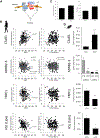Peptide/Receptor Co-evolution Explains the Lipolytic Function of the Neuropeptide TLQP-21
- PMID: 31484069
- PMCID: PMC6753381
- DOI: 10.1016/j.celrep.2019.07.101
Peptide/Receptor Co-evolution Explains the Lipolytic Function of the Neuropeptide TLQP-21
Abstract
Structural and functional diversity of peptides and GPCR result from long evolutionary processes. Even small changes in sequence can alter receptor activation, affecting therapeutic efficacy. We conducted a structure-function relationship study on the neuropeptide TLQP-21, a promising target for obesity, and its complement 3a receptor (C3aR1). After having characterized the TLQP-21/C3aR1 lipolytic mechanism, a homology modeling and molecular dynamics simulation identified the TLQP-21 binding motif and C3aR1 binding site for the human (h) and mouse (m) molecules. mTLQP-21 showed enhanced binding affinity and potency for hC3aR1 compared with hTLQP-21. Consistently, mTLQP-21, but not hTLQP-21, potentiates lipolysis in human adipocytes. These findings led us to uncover five mutations in the C3aR1 binding pocket of the rodent Murinae subfamily that are causal for enhanced calculated affinity and measured potency of TLQP-21. Identifying functionally relevant peptide/receptor co-evolution mechanisms can facilitate the development of innovative pharmacotherapies for obesity and other diseases implicating GPCRs.
Keywords: VGF; drug discovery; granin peptides; innate immunity; lipolytic catecholamine resistance; obesity; transient receptor potential channel.
Copyright © 2019 The Author(s). Published by Elsevier Inc. All rights reserved.
Conflict of interest statement
DECLARATION OF INTERESTS
The authors declare no competing interests.
Figures





Similar articles
-
TLQP-21, A VGF-Derived Peptide Endowed of Endocrine and Extraendocrine Properties: Focus on In Vitro Calcium Signaling.Int J Mol Sci. 2019 Dec 24;21(1):130. doi: 10.3390/ijms21010130. Int J Mol Sci. 2019. PMID: 31878142 Free PMC article. Review.
-
The molecular identity of the TLQP-21 peptide receptor.Cell Mol Life Sci. 2021 Dec;78(23):7133-7144. doi: 10.1007/s00018-021-03944-1. Epub 2021 Oct 9. Cell Mol Life Sci. 2021. PMID: 34626205 Free PMC article. Review.
-
The neuropeptide TLQP-21 opposes obesity via C3aR1-mediated enhancement of adrenergic-induced lipolysis.Mol Metab. 2016 Oct 31;6(1):148-158. doi: 10.1016/j.molmet.2016.10.005. eCollection 2017 Jan. Mol Metab. 2016. PMID: 28123945 Free PMC article.
-
The TLQP-21 peptide activates the G-protein-coupled receptor C3aR1 via a folding-upon-binding mechanism.Structure. 2014 Dec 2;22(12):1744-1753. doi: 10.1016/j.str.2014.10.001. Epub 2014 Nov 13. Structure. 2014. PMID: 25456411 Free PMC article.
-
Characterization of a novel peripheral pro-lipolytic mechanism in mice: role of VGF-derived peptide TLQP-21.Biochem J. 2012 Jan 1;441(1):511-22. doi: 10.1042/BJ20111165. Biochem J. 2012. PMID: 21880012
Cited by
-
TLQP-21, A VGF-Derived Peptide Endowed of Endocrine and Extraendocrine Properties: Focus on In Vitro Calcium Signaling.Int J Mol Sci. 2019 Dec 24;21(1):130. doi: 10.3390/ijms21010130. Int J Mol Sci. 2019. PMID: 31878142 Free PMC article. Review.
-
Stress and Alzheimer's disease: A senescence link?Neurosci Biobehav Rev. 2020 Aug;115:285-298. doi: 10.1016/j.neubiorev.2020.05.010. Epub 2020 May 24. Neurosci Biobehav Rev. 2020. PMID: 32461080 Free PMC article. Review.
-
The molecular identity of the TLQP-21 peptide receptor.Cell Mol Life Sci. 2021 Dec;78(23):7133-7144. doi: 10.1007/s00018-021-03944-1. Epub 2021 Oct 9. Cell Mol Life Sci. 2021. PMID: 34626205 Free PMC article. Review.
-
VGF-derived peptide TLQP-21 modulates microglial function through C3aR1 signaling pathways and reduces neuropathology in 5xFAD mice.Mol Neurodegener. 2020 Jan 10;15(1):4. doi: 10.1186/s13024-020-0357-x. Mol Neurodegener. 2020. PMID: 31924226 Free PMC article.
-
Lipolysis drives expression of the constitutively active receptor GPR3 to induce adipose thermogenesis.Cell. 2021 Jun 24;184(13):3502-3518.e33. doi: 10.1016/j.cell.2021.04.037. Epub 2021 May 27. Cell. 2021. PMID: 34048700 Free PMC article.
References
-
- Arner P (1999). Catecholamine-induced lipolysis in obesity. Int. J. Obes. Relat. Metab. Disord 23 (Suppl 1), 10–13. - PubMed
-
- Bartolomucci A, La Corte G, Possenti R, Locatelli V, Rigamonti AE, Torsello A, Bresciani E, Bulgarelli I, Rizzi R, Pavone F, et al. (2006). TLQP-21, a VGF-derived peptide, increases energy expenditure and prevents the early phase of diet-induced obesity. Proc. Natl. Acad. Sci. USA 103, 14584–14589. - PMC - PubMed
MeSH terms
Substances
Grants and funding
LinkOut - more resources
Full Text Sources
Other Literature Sources
Molecular Biology Databases
Research Materials
Miscellaneous

